The Asteria was a coastal submarine of the Platino class, “600” series, type Bernardis, with a displacement of 712 tons on the surface and 865 tons submerged. During the war, it completed 9 offensive or exploratory patrols, mainly in the central Mediterranean, and eight transfer journeys, covering 10,842 miles on the surface and 1,370 miles submerged, and spending 97 days at sea.
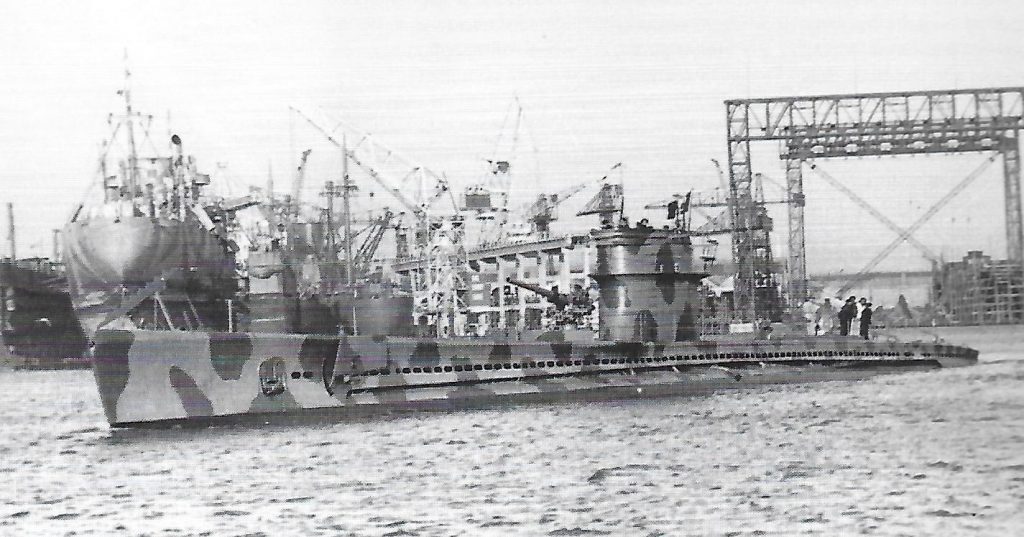
The Asteria soon after delivery to the Regia Marina photographed on November 27th, 1941.
(Photo Collezione Turrini)
Brief history
October 16th, 1940
The boat was set up at the Cantieri Riuniti dell’Adriatico in Monfalcone. Build number 1262.
June 25th, 1941
The boat was launched at the Cantieri Riuniti dell’Adriatico (C.R.D.A.) in Monfalcone.
November 8th, 1941
The boat entered active service immediately after a period of intense training.
February 9, 1942
Antonio Pardo, 21, from Portici, died on the Asteria in the central Mediterranean.
May 13th, 1942
The boat began the first war patrol, in the waters off Cyrenaica.
May 15th, 1942
The Asteria, while emerging in the evening to begin the night patrol on the surface, spotted a destroyer that was approaching at high speed in an attempt to ram it. The submarine quickly dove and it was then subjected, for a long time, to a hunt with depth charges, but damage was not serious. The boat continued its mission, concluding it on May 24th.
July 7th, 1942
Asteria (Lieutenant Pasquale Beltrame) took position between Cyprus and Syria for a week, and there were no sightings.
July 14th, 1942
At 02:00 AM of July 14th, the lookouts spotted a unit at a short distance that was identified as a destroyer and attacked it with the launch of a torpedo, which was avoided with a maneuver. The Asteria launched another one and then heard a loud explosion, however no enemy units are damaged.
On the evening of July 14th, at 11:47 PM, the boat was sighted in position 33°57′ N and 34°34′ E (about fifty miles west of Beirut), while sailing on the surface with a 100° course, by the British submarine H.M.S. Turbulent (from half a mile away). The Asteria, having already sighted H.M.S. Turbulent from 1000 meters away and believing it to be an Italian submarine with a course of 290° (the position given, 33°52′ N and 34°46′ E, is slightly different from that indicated by the British unit), turned to starboard and moved away at maximum speed to lose contact (probably in order to avoid mishaps). H.M.S. Turbulent, which correctly identified the unknown submarine as an Italian unit, mistakenly believed that it had dived, therefore, a minute later (at 11.48 OM) it dove in turn. This is how the meeting ended.
August 12th, 1942
The boat was deployed west of Malta to counter the British operation “Pedestal” (Battle of Mid-August). No major events.
November 13th, 1942
The Asteria (Lieutenant Dante Morrone) sighted two smaller units in the waters of Capo Carbon and at 02.05 AM launched two torpedoes against one of them. Due to the high phosphorescence of the water, the ship sighted the torpedoes in time and avoided them with a maneuver. Then the Asteria was subjected to a hard chase with several depth charges, from which, however, it managed to escape with only minor damage.
At 12.45 PM of the same day, the Asteria, on its way back to to base (according to another version to return to the patrol area), was attacked by a Lockheed Hudson of the USAAF (?), which attacked with bombs dropped at low altitude, but the boat avoided the bombs with a maneuver – only one exploded, on deck, without incredibly causing serious damage – and returned fire with the machine guns, damaging the plane which flew away with an engine on fire.
December 4th, 1942
During a mission off Algeria, in the evening of December 4th, the Asteria, while coming to the surface at six miles by 45° from Cape Fer, hit the keel of a British corvette with the conning tower. The boat immediately dove, but suffered a long bombardment with depth charges, suffering serious damage (in addition to those already sustained in the collision), which forced it to return to Cagliari.

The damage to the conning tower of the Asteria
(Photo STORIA militare)
December 16th, 1942
Second Lieutenant Pietro Eugeni, 21, from Rome, died on the Asteria in the central Mediterranean.
The Last Mission and the Sinking
On February 11th, 1943, after the completion of the repair works, the Asteria, under the command of Lieutenant Dante Morrone, left Naples for the ninth war patrol, an ambush to counter Allied traffic to and from the port of Bougie (Algeria). On February 13th, the submarine arrived in the assigned patrol area, off Cape Carbon. No ships were sighted for four days, but at 3 AM on February 17th, the boat spotted two enemy units not far away, searching for submarines.

Lieutenant Dante Morrone, born in Ravenna January 28th, 1914, the last commander of the Asteria.
Note the “wings” on his uniform as he was a “osservatore aereo”.
(Photo Giovanni Pinna)
They were the British destroyer escort H.M.S. Wheatland (sometimes mistakenly referred to as “Westland”; under the command of Lieutenant Commander Ronald L. Brooke, who would receive the Distinguished Service Order for the action) and H.M.S. Easton of the Hunt class (under the command of Lieutenant C. Wickham Malins, who would receive a second Distinguished Service Cross for the action), which together with two other destroyers of the same class, H.M.S. Lamerton (which had already sunk the submarine Ferraris in the Atlantic) and H.M.S. Bicester, were escorting an Allied convoy off the Algerian coast.
The Asteria, remaining on the surface, immediately maneuvered to approach the launch distance and, having reached 700 meters, prepared to attack with the torpedoes, but H.M.S. Wheatland and H.M.S. Easton (H.M.S. Bicester and H.M.S. Lamerton took part in the search for the submarine, in defense of the convoy, but not in the hunt) located the submarine with radar and at first tried to ram it, then, after the boat had made the rapid dive to avoid collision, they bombarded it with depth charges. According to the book “Ultra Versus U-Boats: Enigma Decrypts in the National Archives”, however, it was H.M.S. Wheatland and H.M.S. Easton that first sighted the Asteria, which was sailing west at eight knots, when their ASDICs reported contact less than 1200 meters away. The Asteria, for its part, sighted the two destroyers, in conditions of poor visibility, and Commander Morrone ordered the dive.
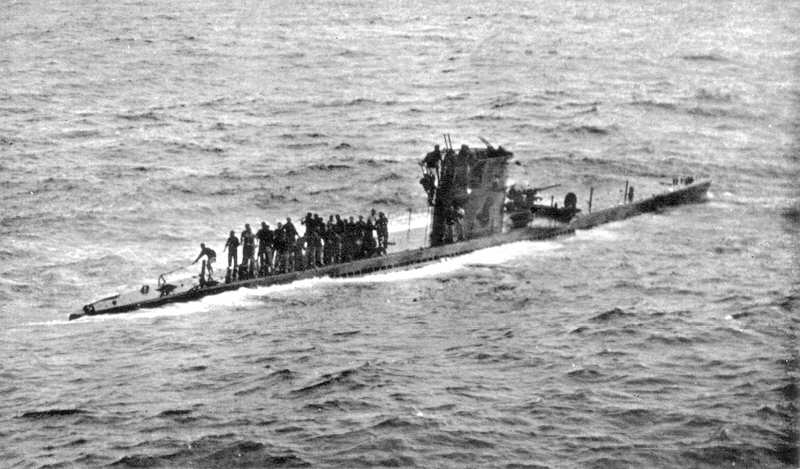
The Asteria on the surface just before being scuttled by its crew
(Photo ‘The National Archives”, U.K.)
The Asteria suffered seven hours of bombardment, suffering severe damage to various equipment. First, immediately after spotting the submarine, H.M.S. Wheatland dropped five depth charges adjusted to a depth of 15 meters, which caused some damage, then the hunt continued for about an hour, after which contact was lost for two hours. Then H.M.S. Easton carried out another attack, very effective, which totally put the Asteria’s engines out of control: the submarine, having run out of compressed air – and therefore no longer being able to change its depth adequately, and having discharged the batteries of the electric motors, had to surface, so that at least the crew could get to safety.
As soon as it reached the surface, the Asteria was immediately hit by the fire of H.M.S. Wheatland and H.M.S. Easton’s guns, which caused further damage and killed four men. When they realized that the submarine was sinking, the two destroyers ceased fire. The rest of the crew surrendered, started the scuttling maneuvers (according to another version the procedures for scuttling had already begun during the surfacing maneuver) and abandoned the unit, which at 9.40 AM of February 17th sank astern at 37°14′ N and 04°27′ E (for another source 37°14′ N and 04°50′ E), about 25 miles northwest of Bougie.
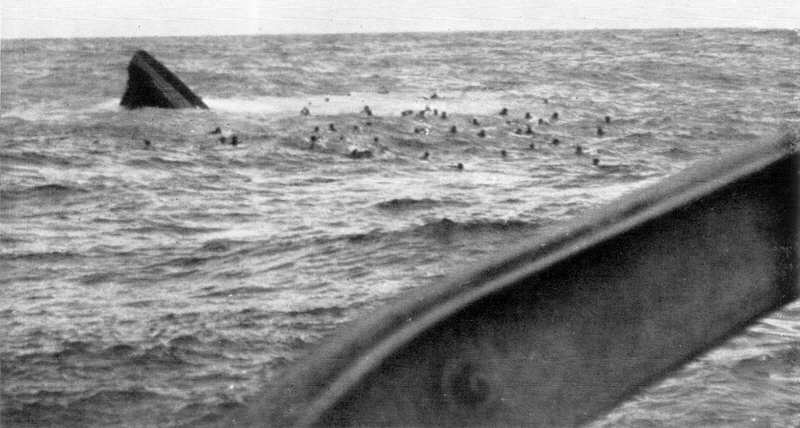
The final moments of the Asteria
(Photo ‘The National Archives”, U.K.)
The version proposed when Commander Brooke of H.M.S. Wheatland’s died, however, differs in several respects. According to this version, H.M.S. Wheatland was on patrol off Bougie with H.M.S. Bicester, H.M.S. Easton, and H.M.S. Lamerton, when, shortly before midnight on February 16th, H.M.S. Wheatland spotted a dark shape ahead of her and went on the attack; the contact disappeared and H.M.S. Wheatland, in spite of problems with the Asdic, continued the chase throughout the next day until shortly before midnight, when the Asteria, which had been seriously damaged during the first attack on H.M.S. Wheatland and had not been able to get away, had to surface, having run out of air. It then surrendered and was scuttled. However, this version has several errors, for example in the timing, because the photos taken of the sinking Asteria clearly show that the boat sank when the sun was still brightening the day, so certainly not around midnight.
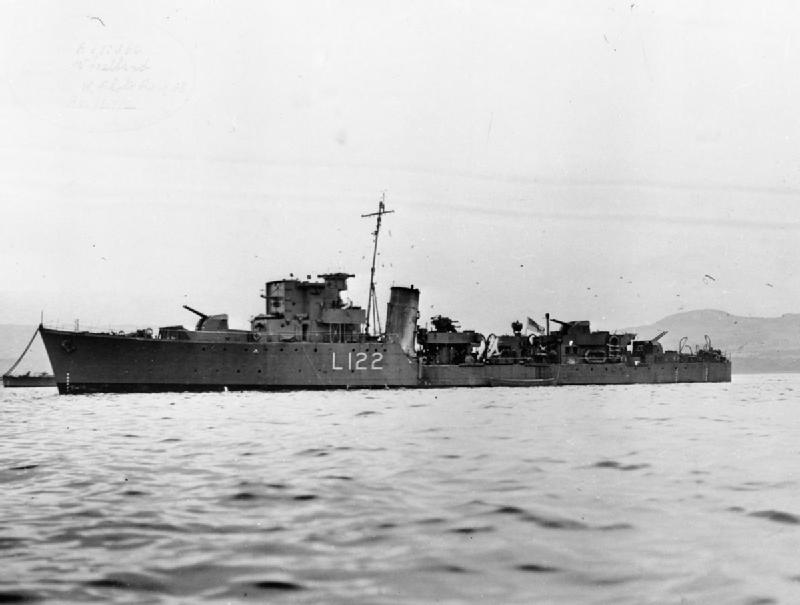
H.M.S. Wheatland
Commander Morrone, after ordering the crew to abandon ship, remained on board until the end, saving himself last (recalling the episode decades later, he said that he risked “being hit by the machine guns of enemy planes”). He was awarded a silver medal for Military Valor, the second for him (the first had been awarded in 1940 for his activity as an observer on reconnaissance aircraft). The 46 survivors (for another version 47 or 48) were rescued by H.M.S. Wheatland and H.M.S. Easton, and ended up in captivity in North Africa, Britain, and the United States. Commander Morrone returned to Italy in 1946.
Details on the casualties of the sinking of the Asteria:
- Ugo Baldini, sub-chief engineman, 22 years old, from Ancona
- Biagio Di Salvo, sailor electrician, 21 years old, from Caronia
- Giovanni Mazzon, second chief torpedo pilot, 20 years old, from Roncade
- Umberto Terigi, sub-chief gunner, 20 years old, from Camaiore
One of the survivors, sailor helmsman Nicola Daugenti, 21, from Noicattaro, died while a POW in the United States on August 27th, 1943.
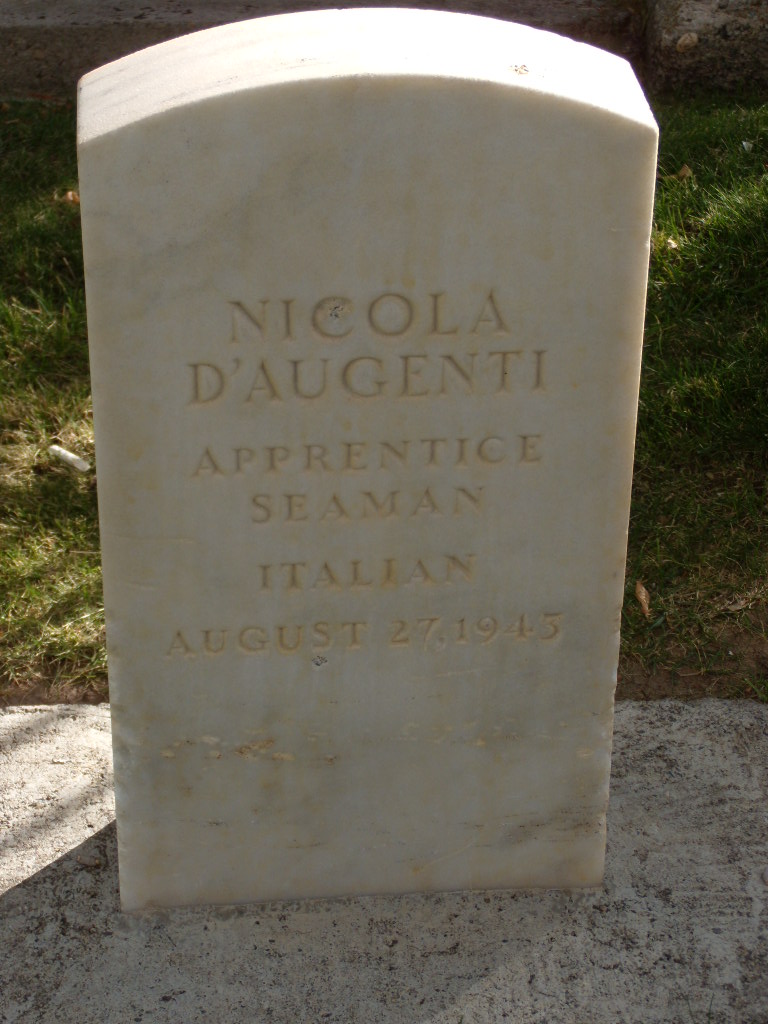
Historic Fort Douglas Cemetery (Utah, USA), the grave of Nicola Daugenti
Original Italian text by Lorenzo Colombo adapted and translated by Cristiano D’Adamo
Operational Records
| Type | Patrols (Med.) | Patrols (Other) | NM Surface | NM Sub. | Days at Sea | NM/Day | Average Speed |
|---|---|---|---|---|---|---|---|
| Submarine – Coastal | 17 | 10842 | 1370 | 93 | 131.31 | 5.47 |
Actions
| Date | Time | Captain | Area | Coordinates | Convoy | Weapon | Result | Ship | Type | Tonns | Flag |
|---|---|---|---|---|---|---|---|---|---|---|---|
| 7/4/1942 | 2:10 | T.V. Pasquale Beltrame | Mediterranean | 33°48’N, 34°56’E | Torpedo | Failed | HMSAS Protea (?) | Armed Whaler | 955 | South Africa | |
| 11/13/1942 | 01:00 | T.V. Dante Morrone | Mediterranean | 36°46’N, 05°08’E | Torpedo | Failed | HMS Pentstemon | Corvette | 940 | Great Britain |
Crew Members Lost
| Last Name | First Name | Rank | Italian Rank | Date |
|---|---|---|---|---|
| Baldini | Ugo | Junior Chief | Sottocapo | 2/17/1943 |
| Daugenti | Nicola | Naval Rating | Comune | 8/27/1943 |
| Di Salvo | Biagio | Naval Rating | Comune | 2/17/1943 |
| Eugeni | Pietro | Sublieutenant | Sottotenente di Vascello | 12/16/1942 |
| Mazzon | Giovanni | Chief 2nd Class | Capo di 2a Classe | 2/17/1943 |
| Mazzon | Giovanni | Junior Chief | Sottocapo | 2/17/1943 |
| Pardo | Antonio | Naval Rating | Comune | 2/9/1942 |